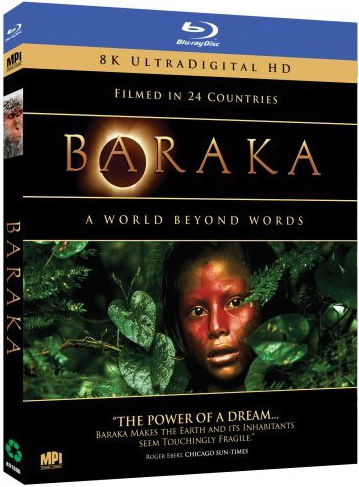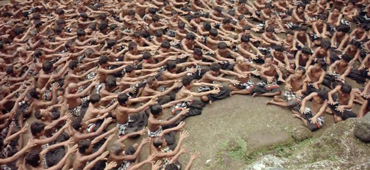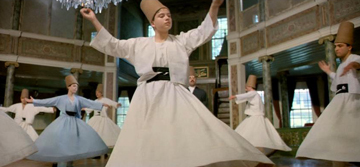| Release List | Reviews | Price Search | Shop | Newsletter | Forum | DVD Giveaways | Blu-Ray/ HD DVD | Advertise |
| Reviews & Columns |
|
Reviews DVD TV on DVD Blu-ray International DVDs Theatrical Reviews by Studio Video Games Features Collector Series DVDs Easter Egg Database Interviews DVD Talk TV DVD Talk Radio Feature Articles Columns Anime Talk DVD Savant HD Talk Horror DVDs Silent DVD
|
DVD Talk Forum |
|
|
| Resources |
|
DVD Price Search Customer Service #'s RCE Info Links |
|
Columns
|
 |
Baraka |

|
Baraka Blu-ray MPI 1992 / Color / 2:21 widescreen / 97 min. / Street Date October 28, 2008 / 34.98 Cinematography Ron Fricke Film Editor David Aubrey, Ron Fricke, Mark Magidson Original Music Michael Stearns Written by Constantine Nicholas, Genevieve Nicholas Produced by Mark Magidson, Alton Walpole Directed by Ron Fricke |
Godfrey Reggio's 1984 Koyanniskatsi pioneered the genre of the non-narrative documentary, a movie comprised of documentary images and music, which communicates its themes through its visuals. The cameraman on that film was Ron Fricke and his tool of choice was the time-lapse camera that compresses hours into seconds. Fricke continued separately from Reggio on 1985's Chronos, an IMAX eye-opener that takes a time-lapse travelogue tour of fantastic sights around the world. Filmed in 70mm, Baraka (1992) is Ron Fricke's most impressive film to date. It's more than a travelogue and much more than a gimmick, as it views the human experience in many different cultures.
MPI's Blu-ray of Baraka gives us a stunning Hi-Def transfer of a film that still fills the American Cinematheque for infrequent 70mm showings. Even if one isn't prone to connect with its transcendental philosophy, Fricke's meticulously photographed film may be the best-looking Blu-ray yet to surface.
Read any filmmaker's analysis of films like Baraka and the same ideas pop up -- the movie has no narrative but instead wishes to serve as a meditation on man's place on Earth and in the Universe. Ron Fricke and Godfrey Reggio parted ways after Koyannisqatsi but their subsequent features retain a lot in common. Reggio's 1988 Powaqqatsi is a structured look at human civilization as seen in societies from the primitive to the modern; somewhere along the way it morphs into an anti-technology, anti-materialist plea for a return to spiritual values. Philip Glass's hypnotic music score eventually becomes quite militant, and the contrast between Evil modernity and Blessed antiquity makes the movie less of a meditation and more of a sermon.

Baraka presents the same basic statement with a lighter, less political touch. Like the "Dance Around the World" theme of Wim Wenders' Until the End of the World, Fricke leaps between cultural rituals in the lives of people on every continent. In Africa and the South American jungle there seems little distinction between ritual and everyday life; the film shows tribal make-ups almost in medley form. Worshippers gather in numbers large and small, in contrasting rites that nevertheless have the same aim of spiritual harmony. Thousands of Muslims circle a giant tomb in Mecca, a fantastic sight in widescreen 70mm. Funeral pyres on the Ganges are beautiful and grisly, as bodies are burned in full view of thousands of spectators.
Balancing the anthropological content is a visual record of earthly beauties that shows the reality of nature as something worth worshipping. Through Fricke's time-lapse lens we visit sites where traces of ancient civilizations are still standing -- Egypt, Cambodia, Iran. The wonder of time-lapse also shows magical places like Arches National Monument in Utah, where terrestrial landscapes suggest spiritual values beyond everyday reality.
To represent the modern world, Frick falls back on visuals of automated assembly lines where life is processed into a factory product. An extended montage shows an factory hatchery in which thousands of baby chicks are moved about on conveyor belts, dropped through chutes and funnels and otherwise handled worse than Charlie Chaplin in Modern Times. The only time they're touched by human hands is to have their beaks burned on a hot metal bar -- to be "de-beaked" so they can't peck each other to death. The most compelling image in the sequence is a conveyor belt that moves an endless line of anonymous, confused chicks to a drop-off point, where they tumble into their next unknown adventure without any warning whatsoever. This visual frequently disturbs animal lovers. Just the same it's a perfect metaphor for the "What - me worry?" helplessness of modern humanity, never knowing what's going to hit them next.

Naturally, Fricke cuts to time-lapse images of people being processed in the same way, mostly scurrying through train stations, lining up to ride escalators, and moving in their cars down endless rows of synchronized traffic signals in Manhattan. It may be student-film stuff, but it's still the truth of our times.
What distinguishes Baraka from earlier shows are Fricke's camera refinements. Time-lapse shots increase and decrease shutter speeds, adding a slight slit-scan quality to some views. Fricke also adds ultra-smooth automated pans that impose a second frame of reference on shots already unbound by time. Since a pan mirrors the act of turning one's head, these scenes seem to reflect the view of some superhuman entity living in a different time frame.
Fricke creates some haunting astronomical scenes, doing time-lapse on nighttime views that show rocks and trees lit only by moonlight. The moon cruises like a glowing headlight through the sky, while the stars spin around the polar point. It's a perfect expression of Earth's modest place in the cosmos, and Fricke uses it for his final image.

Ron Fricke is said to be preparing a new movie called Samsara. The IMDB description makes it seem very much like the same kind of visual wonder show.
MPI's Blu-ray of Baraka is the kind of movie you don't want to turn away from -- every new shot is a revelation, from a contemplation of a snow monkey sitting in a hot spring, to a vista of junked Air Force bombers neatly arranged across an endless desert. Savant's favorite -- the interior of a Mosque (?) that appears to be tiled with a million diamonds. Michael Stearns' orchestral score has been restored and remixed in both DD 5.1 and DTS-HD Master Audio 5.1.
The disc contains two extra featurettes, one a making-of discussion by Fricke and his filmmakers, and the second a look at the film's restoration. Baraka was scanned for video at an astonishing 8K Ultra High Resolution from its 65mm film elements. We're also told that, because Fricke hadn't the budget to rent expensive 65mm cameras for the project, he engineered and built his own -- all of the amazing images and time-lapse effects were created in cameras fashioned by the filmmaker himself.
On a scale of Excellent, Good, Fair, and Poor,
Baraka Blu-ray rates:
Movie: Excellent
Video: Excellent
Sound: Excellent
Supplements: two Featurettes
Packaging: Folding card disc carrier (disc resides in a card slot)
Reviewed: October 27, 2008
Reviews on the Savant main site have additional credits information and are more likely to be updated and annotated with reader input and graphics.
Review Staff | About DVD Talk | Newsletter Subscribe | Join DVD Talk Forum
Copyright © MH Sub I, LLC dba Internet Brands. | Privacy Policy
Subscribe to DVDTalk's Newsletters
|
| Release List | Reviews | Price Search | Shop | SUBSCRIBE | Forum | DVD Giveaways | Blu-Ray/ HD DVD | Advertise |





